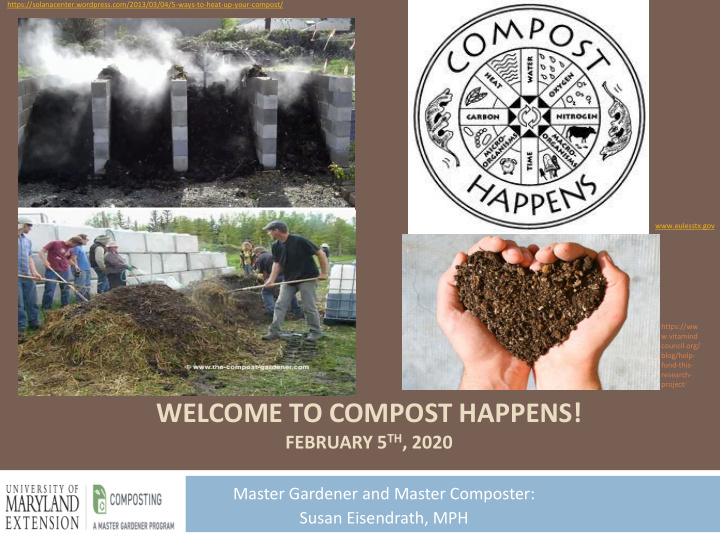



https://solanacenter.wordpress.com/2013/03/04/5-ways-to-heat-up-your-compost/ www.eulesstx.gov https://ww w.vitamind council.org/ blog/help- fund-this- research- project / WELCOME TO COMPOST HAPPENS! FEBRUARY 5 TH , 2020 Master Gardener and Master Composter: Susan Eisendrath, MPH
Derwood Compost & Urban Farmette Credit: Susan Eisenddrath
Agenda Objectives Who is Composting? Basics of Composting Q&A Action Plans http://pulsosocial.com/en/2013/03/22/agenda-brazil-three-tech-events-to-check-out- this-weekend/
Objectives Define compost and composting Identify the environmental problems that composting addresses Explain the benefits of composting Become aware of the compost food web Know how to compost Know some main composting methods Understand how to use compost Improve your own composting Know key information for teaching composting
Handouts and Resources Credit: Susan Eisendrath
Composting or Not? How many of you compost? Why? How? What? Problems? Why not? http://www.jobinterviewquestions.org/interview-questions-and-answers/
What is compost and what is composting? https://www.epa.gov/recycle/composting-home https://rosecottagegarden.blogspot.com/2009/01/compost-central.html
Compost and Composting is… Compost : A dark, crumbly, earthy- smelling material produced by the natural decomposition of organic materials. Composting : The aerobic, or oxygen- requiring, decomposition of organic materials by microorganisms, under controlled conditions. During composting, the microorganisms consume oxygen. Active composting generates heat, carbon dioxide, and water vapor. Composting reduces the volume and mass of the raw materials while transforming them into a valuable soil conditioner. http://go2add.com/newtech/composting.php
Why do we need to compost? http://whyfiles.org environmental http://www.energyjustice.net/biomass problems /2011/trash- does-burning-beat- burying/ http://www.optimumgarden.com/controlling-pests-in-your-garden/ http://www.roomtogrow.co.uk/blog/growing-vegetable-patch-kids/
4 Principles of Soil Health National Resources Conservation Districts, USDA, 2018
Add Compost = Add Soil Organic Matter http://www.treepower.org/soils/soilorganicmatter.html
Benefits of Compost Increases beneficial living microorganisms, worms, insects in soils Creates a rich nutrient-filled material, humus Improves soil tilth, aeration, and water-holding capacity Reduces or eliminates the need for chemical fertilizers Suppresses soil-borne plant diseases and pests Promotes higher yields of agricultural crops Helps regenerate poor soils Has the ability to cleanup (remediate) contaminated soil Saves gardeners the money used to buy alternatives such as peat moss, fertilizer, or vermiculite Slide Adapted from: Institute for Local Self Reliance
OTHER Benefits of Composting & Compost Reduces waste Cuts emissions from landfilling & trash burning Reduces stormwater run-off & soil erosion Creates jobs & supports local economies Protects the climate Total MSW Generation (by Material), 2013 254 Million Tons (before recycling) Source: https://archive.epa.gov/epawaste/nonhaz/municipal/web/html/ Adapted Slide: Institute for Local Self Reliance
Soil, Microbes, & Carbon Pool Illustration by Krishna Chavda
Compost and Stormwater Management Erosion and sediment control Sediment Trap Aids water conservation Improves water retention Improves soil quality and structure Slope Protection and Erosion Control Blanket Vegetated Walls Above photos courtesy: Filtrexx 15 Slide Adapted From: Institute for Local Self Reliance Source: David McDonald, Seattle Public Utilities & Washington Organic Recycling Council, Soils for Salmon Project.
Rainscapes Rewards Rebate Program Property owners offered rebate for low-impact development installations Best Management Practices for rain gardens: amend soil with compost Conservation landscapes: required to have 3-inch layer of compost (incorporated to create a 6-12 inch improved soil layer) Credit: City of Portland, Oregon Bureau of Environmental Services
Local Composting County Dept. of City of Takoma Park Environmental Prince George’s Food Protection Division of Waste Composting Solid Waste Services: DC Neighborhood Soil Backyard, Yard Waste, Rebuilders Food Waste Pilot, Community Strategic Plan Composting Program Compost Crew, MD Dept. of Veterans Compost, Enviroment Compost Cab
County Strategic Plan Reducing food On-farm composting waste/channeling Commercial food to others composting Backyard Strategies to composting & maximize collection Community-scale at the curb composting On-site institutional/on-site business composting
Blair HS, 3 Bin System & Koiner Farm Credit: Susan Eisendrath Credit: Susan Eisendrath https://www.facebook.com/CharlesKoinerFarm/ph otos/a.1103036646498028/1451492741652415/?ty pe=3&theater
Compost Basics Image: University of Maryland Master Gardener Handbook (2008), p. 79
6 Key Composting Factors The Rot Stars: microorganisms digest organic 1. matter Air/Oxygen 2. Water/Moisture 3. Food (balance carbon to nitrogen ratio = “green” 4. and “brown” ingredients) Particle Size 5. Pile Volume 6. https://www.flickr.com/photos/75012107@N05/
Compost Food Web Compost is a living soil amendment. Bacteria, fungi, and microbes feed on organic matter. Microbes use carbon and nitrogen to grow and reproduce. Several cycles of organisms are needed for decomposition. Image: University of Maryland Master Gardener Handbook (2008), p. 80 https://gardening.stackexchange.com/questions/1241/ant-colony-in-my-compost-bin-are-they-beneficial
Soil Biota: Worms, Pill Bugs, Springtail, Bacteria, Protozoa, Mycorrhizal, Nematodes https://upload.wikimedia.org/wikipedia/commons/7/77/Mycorhiz ae_fungus_%2810333483254%29.jpg http://www.nrcs.usda.gov/wps/portal/nrcs/photogallery/soils/health/biology/galle ry/?cid=1788&position=Promo
Compost Phases http://teca.fao.org/es/read/8368
Underground Attraction https://str.llnl.gov/april-2016/pettridge
Composting Ingredients: Organic Materials GREEN/Nitrogen material : Grass, green yard trim, kitchen waste BROWN/Carbon material : Leaves http://www.dailymail.co.uk/news/article-2511158/Adorable-lion-cub-Karis-loves-playing-Autumn-leaves-keepers-swept-enclosure.html
Composting Factors Moisture : Enough water so that the compost feels like a damp sponge. Air : Pay attention to porosity. Turn the compost weekly for about three weeks or more. Credit: Susan Eisendrath
Compost Factors Heat : High temperatures (131 – 153 degrees) break down the compost faster and help microbes decompose it. Particle Size : 1/8 th to 2 inches to http://www.cleanairgardening.com/compost-thermometer-g20p/ provide more surface area for the microbes to do their decomposition work. https://montanawildlifegardener.blogspot.com/2012/05/international-compost-awareness-week.html
Compost Factors Volume : Make the compost pile at least 3 x 3 x 3 feet to hold heat in and no bigger than 5 x 5 x 5 feet so it can be turned. http://whatcom.wsu.edu/ag/compost/fundamentals/needs_placement_structures.htm https://www.google.com/search?q=usda+compost+images&tbm=isch&tbo=u&source=univ&sa=X&ved =0ahUKEwj58Kiq2fzRAhXJrVQKHTlxBEcQsAQIGw&biw=1304&bih=699#imgrc=PHmGlLubHZUd4M:
Compost Recipe 3 Buckets of BROWNS and 1 Bucket of GREENS Put alternating layers of Browns and Greens on the pile until it is at least a 3 feet x 3 feet x 3 feet pile and mix the layers. To help start it, you can also sprinkle some soil on top of each layer of Brown or Green. Water each layer (should be moist as damp sponge).
Compost Materials Do Compost: Green/Nitrogen Material Garden/yard trimmings, coffee grounds, fruit & vegetable waste (in rodent proof containers), and fresh hay (without pesticides & herbicides) Manure: cow, horse, poultry, sheep, rabbit.
Compost Materials Brown/Carbon Material: Leaves, straw & hay (without pesticides & herbicides) Sawdust & wood chips, woody yard trimmings. Avoid Composting: Cat and dog manure, dairy and meat, weeds with seeds, diseased plants, wood ashes.
Basic Composting Tools Credit: Susan Eisendrath Credit:https://www.flickr.com/photos/andrea_44/ http://rosenotes.typepad.com/.a/6a010535bf3807970c011168886c92970c-pi Credit: Susan Eisendrath
Pipes and Tarps http://indulgy.com/post/Nx4HZ88Sk2/secret-weapon-for-compostingpvc-pipe Credit: Susan Eisendrath
Aerating with Perforated PVC Pipes http://www.uvm.edu/sustain/news-events/blog/compost-power-project-heating-up-0 http://www/uri/edu/healthylandscapes/livestock/how_manure_composting.html http://pubs.ext.vt.edu/406/406-208/406-208.html
Watering Devices http://www.terapeak.com/worth/yard-butler-free-standing-garden-hose-hanger-w- https://www.epa.gov/soakuptherain/soak-rain-rain-barrels faucet-gardenhose-holder-rack/281912792120/
Recommend
More recommend